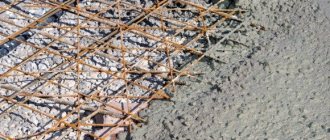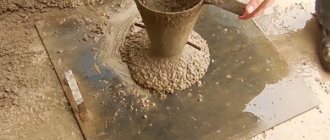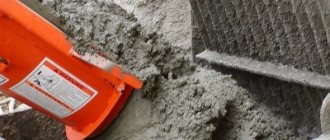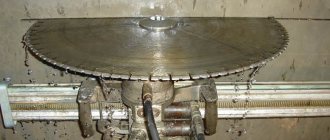When choosing a concrete mixture, not only the grade of concrete (M) and strength class (B), but also its workability are of great importance. What is workability? This is the ability of the concrete mixture to easily and completely fill the form, as well as the ability not to delaminate during transportation and storage.
GOST 7473-2010
. Concrete mixtures. Technical conditions, depending on the workability indicator, divide concrete mixtures into the following 4 groups of grades:
- Marks according to the spread of the cone (P1 - P6), where P is the spread;
- Marks based on cone draft (P1–P5), P—mobility;
- Stiffness grades (Zh1 - Zh5), Zh - hardness;
- Compaction grades (KU1 – KU), KU – compaction coefficient.
Builders are primarily interested in two parameters: mobility and rigidity.
What is the hardness of a concrete mixture?
The concept of concrete mixture rigidity is a technological characteristic of the workability of the material. The method for determining this indicator is based on measuring the time during which the cement mixture completely settles, compacts and levels out.
This indicator must be measured in a specially molded cone and on a specially prepared vibrating platform. In this case, the maximum grain size of the concrete mixture filler can be 4 cm. The test time period is from the moment the laboratory equipment is turned on until the concrete block begins to appear in the holes of the installation disk (at least 2). Measurements are recorded in seconds.
Hardness grades according to GOST 7473 2010
According to GOST 7473-2010, the following grades of concrete mix hardness are established:
| Brand | Hardness, seconds |
| Zh1 | from 5 to 10 |
| Zh2 | from 11 to 20 |
| Zh3 | from 21 to 30 |
| Zh4 | from 31 to 50 |
| Zh5 | from 50 |
Concrete mixture Zh1 is considered the least rigid, Zh5 - the most rigid. The longer it takes for shrinkage and compaction to occur, the stiffer the concrete is.
Building blocks. Methods for determining the hardness of a concrete mixture
The workability of a concrete mixture is characterized by such indicators as mobility and rigidity.
Concrete mixtures for wall building blocks produced on vibration machines (in other words, concrete presses ) “Vibromaster-Professional”, “Vibromaster-Universal”, “Vibromaster-Hermes”, “Vibromaster-Leader”, “Vibromaster-Standard” , are characterized by a stiffness index , which is installed using a device for determining the hardness of a concrete mixture (technical viscometer) according to the GOST 10181.1-81 method. The hardness of a concrete mix is characterized by the vibration time in seconds required to vibrate and compact a preformed cone of concrete mix in a concrete mix hardness tester (or technical viscometer).
The device for determining the hardness of a concrete mixture is a cylindrical steel vessel with an internal diameter of 240 mm and a height of 200 mm. When determining the rigidity of a concrete mixture, the vessel is installed and secured on a vibration platform with a vibration frequency of 2800-3200 rpm and a vibration amplitude of 0.35 mm. A standard cone is inserted into the vessel, secured and filled with concrete mixture, laying it in three successive layers of the same height. Each layer is bayoneted 25 times with a metal rod with a rounded end with a diameter of 16 and a length of 600 mm. Then, the cone is carefully and strictly vertically removed. Using a tripod, the device disk is released onto the surface of the formed cone of concrete mixture. Then the vibration platform and stopwatch are turned on simultaneously. Vibration is carried out until cement begins to be released from the holes of the disk (disk with a diameter of 230 mm; six holes with a diameter of 5 mm are located evenly along the inner circumference with a diameter of 190 mm). The hardness of a concrete mixture (in seconds) is calculated as the arithmetic mean of two determinations made from one sample of the mixture.
A technical viscometer consists of a cylindrical steel vessel with an internal diameter of 301 and a height of 200 mm and a ring with a diameter of 219 and a height of 130 mm located in it, secured with screws. When determining the hardness of a concrete mixture, a technical viscometer is installed and secured on a vibrating platform. A standard cone is inserted into the cylindrical mold, which is filled with concrete mixture in the order indicated above. After compacting the concrete mixture in the cone, the funnel is removed and the excess mixture is cut off with a trowel flush with the upper edges of the cone. Then the cone is carefully and vertically removed, simultaneously turning on the vibration platform and stopwatch. Vibration is carried out until the concrete mixture, having passed under the inner ring, flows into the outer cylinder, and the level of the mixture in the outer and inner rings becomes the same. The duration of vibration is taken as a measure of rigidity (workability). It is calculated as the average of two determinations made from one sample of the mixture.
In the absence of instruments for determining the hardness of a concrete mixture, it can be determined using a simplified method . To do this, a standard shape (cubic) with an edge of 200 mm is placed on a vibrating table and secured. A standard cone is installed in the mold. Then the cone is filled with concrete mixture according to the method described above. After removing the cone, turn on the vibrating table and stopwatch simultaneously. Vibration is continued until the concrete mixture in the mold takes a horizontal position. Determine the vibration time in seconds. The hardness of a concrete mixture is calculated as the arithmetic mean of two determinations made from one sample of the mixture.
Knowing the hardness of a concrete mixture, determined by one of the methods outlined above, you can use the following table to determine the hardness index of the same concrete mixture, determined by other methods.
Indicators of concrete mix hardness
| *** | Hardness of concrete mixture | |||||||||||
| I | 6 | 7 | 10 | 13 | 17 | 20 | 23 | 27 | 30 | 33 | 37 | 40 |
| II | 10 | 20 | 30 | 40 | 50 | 60 | 70 | 80 | 90 | 100 | 110 | 120 |
| III | 15 | 30 | 45 | 60 | 75 | 90 | 105 | 120 | 135 | 150 | 165 | 180 |
*** Method for determining hardness Note: I - method for determining the hardness of a concrete mixture using a device for determining the hardness of a concrete mixture GOST 10181.1-81; II - method of determining hardness using a technical viscometer; III - a method for determining rigidity using a simplified method.
Vibromaster-Professional, Vibromaster-Universal, Vibromaster-Hermes and Vibromaster-Leader vibration machines are equipped with industrial vibrators with high disturbing force. and, accordingly, higher quality of products made using these vibration machines. What explains this? The fact is that the production of wall building blocks on these vibrating machines can be ensured with a greater rigidity of the mixture than when producing building blocks on other similar installations. Higher rigidity of the mixture, in turn, implies a lower water-cement ratio. This ultimately leads to an increase in the strength and frost resistance of wall blocks produced on Vibromaster vibrating machines.
Appendix : GOST 10181.0-81 Concrete mixtures. General requirements for test methods. (75Kb)
You can also look at the following sections
- Binders
- Fillers
- Microfillers
- Chemical additives
- Water for concrete
- Hardening conditions for building wall blocks
- About cement-soil building wall blocks
- Main characteristics of soils for the production of wall building blocks
- Cements for the manufacture of wall building blocks
- Selection of cement soil compositions
- Basic requirements for building wall blocks made of soil concrete
- About arbolite blocks
- Classification of wood concrete wall blocks
- Materials for the production of wood concrete building blocks: Organic cellulose filler
- Materials for the production of arbolite building blocks: Binders
- Materials for the production of wood concrete building blocks: Chemical additives
- Selection of wood concrete composition
- Hardening and heat treatment of arbolite wall blocks
- Requirements for wall blocks made of wood concrete
- Arbolite blocks and sawdust concrete blocks - differences
- House made of wood concrete blocks or wood: what to choose?
- About adobe blocks
- Basic requirements for adobe blocks
- Materials for the production of adobe wall blocks: Binder - clay soils
- Materials for the production of adobe wall blocks: Aggregates
- Methods for testing clayey soils for adobe production: Methodology for determining clay content
- Methods for testing clayey soils for adobe production: Methodology for determining clay content
- Methods for testing clayey soils for adobe production: Methodology for determining the viscosity of clayey soil
- Preparing soil for the production of adobe building blocks
- Drying and storing adobe building blocks
- Measures to increase the strength and water resistance of adobe wall blocks
- Features of the production of adobe building blocks in winter
- Production of blocks from cementless concrete
- About slag-alkaline concrete
- Requirements for materials for the production of slag-alkaline concrete
- Selection of the composition of slag-alkaline concrete
- Recommended approximate compositions of heavy slag-alkaline concretes
- Production of wall concrete blocks from light slag-alkaline concrete
- Production of wall concrete blocks from fine-grained slag-alkaline concrete
- Production of wall concrete blocks from wood concrete using slag-alkaline binder
- Making blocks with a decorative layer
- Preparation and application of decorative solutions
- Compositions of decorative solutions
Kinds
In terms of workability, cement
compositions are divided into 3 categories:
- F - hard;
- SZh - super-hard;
- P - movable.
Concrete compositions used in industrial activities are evaluated according to several technical parameters.
The main one is workability, which shows:
- the ability of the solution to form a dense, homogeneous mass in the process of filling volumes;
- ease of installation;
- no delamination;
- strength after complete hardening of the composition.
Workability is simultaneously characterized by 3 criteria: mass mobility, material rigidity, solution cohesiveness.
| Grade of cement mortar based on workability | Workability standard according to: | ||
| Hardness, seconds | Mobility, cm | ||
| Cone subsidence | Cone blur | ||
| F - hard mixtures | |||
| Zh1 | From 5 to 10 | ||
| Zh2 | From 11 to 20 | ||
| Zh3 | From 21 to 30 | ||
| Zh4 | From 31 to 50 | ||
| SZh - super-hard solutions | |||
| Zh1 | Up to 50 | ||
| Zh2 | From 51 to 100 | ||
| Zh3 | From 100 | ||
| P - mobile concrete compositions | |||
| P1 | Up to 4 | From 1 to 4 | |
| P2 | From 5 to 9 | ||
| P3 | From 10 to 15 | ||
| P4 | From 16 to 20 | From 26 to 30 | |
| P5 | From 21 | From 31 | |
Hard mixtures
Rigid concrete mixtures contain a minimum amount of water, so the starting material is the most durable. They are also called rammed concrete, which is used for the construction of critical structures.
To obtain maximum density of the material, careful compaction is carried out. During the tamping process, a small amount of water appears on the surface of the product. When you squeeze a hard solution in your hand, a fairly dense lump is formed that does not leave traces of the mixture on the palm. Plastic (moving) trains are easier to prepare.
They have stronger adhesion to reinforcement and form smooth surfaces. When concreting is interrupted using rigid concrete, the individual layers have less adhesion to each other than when using plastic compounds.
The technological process for producing rigid concrete mixtures is more complex and expensive. Therefore, this building material is used more often for the construction of structures that will be subject to heavy loads during operation.
Ultra-hard concrete
To produce super-hard concrete, working mixtures are subjected to hydrothermal treatment. After thorough mixing, the cement compositions are compacted and immediately transferred from a granular state to a solid material. Those. There is no intermediate liquefaction of the composition.
This building material is rarely used in the industrial sector. Such mixtures are often used in technologies for the production of autoclave-hardening materials.
Mobile concrete mixtures
Movable solutions are used for the production of reinforced concrete products and pouring monolithic structures.
Such solutions are marked from P1 to P5:
- mixtures with a minimum mobility index - P1;
- maximum plasticity - P5
For pouring monolithic concrete structures, compositions marked P2, P3 are used. And in mixtures of categories P4, P5, plasticizers are additionally added.
The ability of the solution to maintain a homogeneous structure and not delaminate during its transportation and installation determines the cohesiveness of the composition. During the compaction process, heavy large fillers (granite, crushed stone) sink down, and crushed expanded clay, on the contrary, rises to the surface.
This phenomenon negatively affects the strength and structure of the material. To prevent this, it is necessary to accurately calculate the amount of fine filler, use a minimum amount of water and additionally use special plasticizers.
The workability index depends on the brand of cement, the composition of the cement paste, active additives, the proportion of sand and coarse fillers, as well as the volume of water used for liquefaction.
How is the determination made?
During testing, non-integer values may be obtained; the stiffness indicator is rounded to one second. The test is carried out at least twice, so the average value of two values is taken as the technical characteristic. If the test results do not agree by more than 20%, they are carried out again using a different concrete mixture.
One of the characteristics of concrete mortar is cohesion, which means maintaining the homogeneity of the composition and the absence of delamination during transportation and laying. As a result of compacting the mixture, the particles are compacted, and the remaining water is squeezed into the upper layers of the solution. In this case, cavities are formed under the grains of the bulk filler. If the filler has a high density, then its particles settle. Otherwise, particles of the porous sealant rise to the surface. This deteriorates the structure of concrete, resulting in increased water resistance and decreased frost resistance. To increase cohesion and prevent separation, correctly calculate the quantitative amount of fine aggregate in the concrete mixture and reduce water consumption by mixing plasticizing additives.
In laboratories they use a simple method for determining this value using the technology of B.G. Skramtaev. An ordinary cone is placed in a cubic metal mold. It is freed from supports and the lower diameter is made smaller so that it can easily fit inside the cubic shape.
Such a cone is filled with three layers of the composition. After removing the metal cone, the concrete mixture is examined on a vibrating platform. Vibration is maintained until all corners of the cube are filled with concrete. After the mixture fills the mold and is distributed absolutely horizontally and evenly, the vibration is turned off and the hardness value begins to be determined.
The time during which vibration is maintained depends on the mobility of the solution, the size of the object being formed, the presence of reinforcement, the frequency and amplitude of movement of the vibrating device. The smaller the size of the product and the rigidity of the cement mortar, the less time is needed to completely compact the composition.
Numerous studies show that the stiffness index obtained when using a device with a cylindrical vessel is almost two times less than the index obtained using B.G. Skramtaev’s method.











